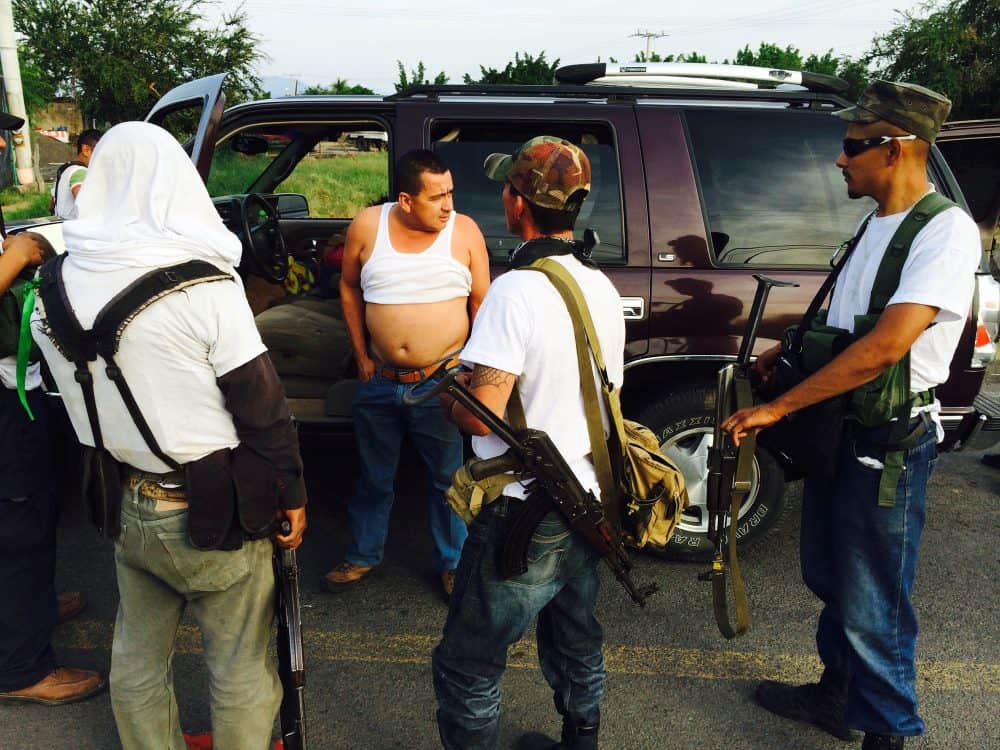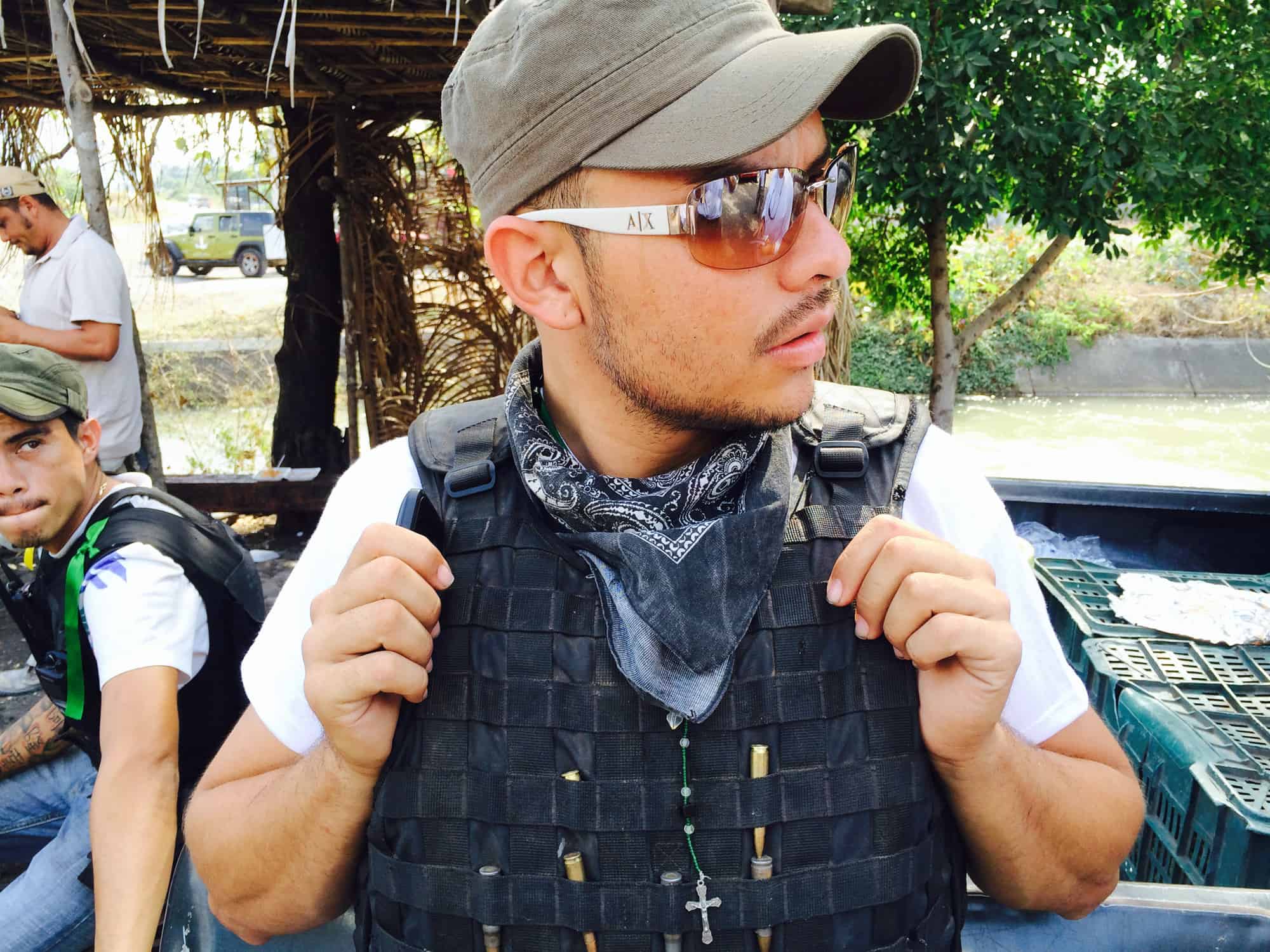LA ESTACIÓN, Mexcio – Jorge Ríos, 11 rifle rounds and a silver cross decorating his black flak jacket, lost his job as a dishwasher in Tucson, Ariz., for driving without a license.
Santos Ramos Vargas, at 43 the oldest of this gang, got deported from Menlo Park, Calif., when he was caught carrying a pistol.
Adolfo Silva Ramos might be with his 2-year-old daughter in Orange County rather than wearing a camouflage cap and combat boots if he hadn’t been busted selling weed and crystal meth while in high school there.
The two dozen men standing guard on a rutted road that cuts through these lime groves and corn fields are just one small part of a citizen militia movement spreading over the lowlands of western Mexico. But as they told their stories, common threads emerged: Los Angeles gang members. Deported Texas construction workers. Dismissed Washington state apple pickers.
Many were U.S. immigrants who came back, some voluntarily but most often not, to the desiccated job market in the state of Michoacán and found life under the Knights Templar drug cartel that controls the area almost unlivable. They took up arms because they were financially abused by the extortion rackets run by the Templars.
Because they had family killed or wounded by their enemies. Because carrying a silver-plated handgun and collecting defeated narcos’ designer cellphones as war booty is more invigorating than packing cucumbers. Because they get to feel, for once, the sensation of being in charge.
“Everybody’s with us, all the people,” said Edgar Orozco, a 27-year-old U.S. citizen who left his job at a Sacramento body shop nine months ago to join the fight after the Knights Templar killed his uncle and cousin. “We’re not going to disarm. Never.”
Up and down the ranks of this group challenging the authority of the Mexican state are men who have brought their formative experiences in the United States to play in this chaotic uprising.
The movement’s top leader, surgeon José Manuel Mireles, lived for several years in Sacramento and worked for the Red Cross. Since he was injured in a plane crash earlier this month, much of the movement’s military leadership has fallen to a 34-year-old El Paso car salesman named Luis Antonio Torres González, known as “El Americano” because he was born in the States. He joined the militia after he was kidnapped on a routine family vacation to Michoacán in October 2012. His relatives sold land and took up collections to pay off his $150,000 ransom.
After that he began plotting with Mireles and others to take revenge on the Knights Templar, an uprising that began last February when residents from three towns – Tepalcatepec, Buena Vista, and La Ruana – marshaled whatever rifles and shotguns they could find and seized control. Since then the militia has spread to more than 20 towns, nearly encircling the region’s largest city, Apatzingán, a stronghold of the drug gang.
The Knights Templar retaliated by attacking electricity substations and burning pharmacies and convenience stores. The militia has achieved what thousands of Mexican soldiers and federal police stationed in Michoacán have failed to do: impede the operations of this powerful cartel on a large scale.
The militia has rapidly won followers, heavier weapons, armored cars. Some of the guns and trucks appear to be scavenged off the battlefield. The militia’s critics say some may be funneled in from a rival drug cartel, New Generation, which operates from the neighboring state of Jalisco.
Government officials are concerned that the militia will turn into the same type of abusive gun gang that prompted its formation. The Knights Templar’s predecessor cartel began with similar rhetoric about defending the people, but from the violent Zetas cartel. The government’s newly appointed envoy in charge of Michoacán’s security, Alfredo Castillo, warned that the militia could abuse its power.
“You can start with a genuine cause, but when you start taking control, making decisions and feeling authority, … you run the risk of getting to that point,” he said on the radio.

By his own admission, Moises Verduzco had never been “a good boy.” Raised a foster child in Hawthorne, Calif., he spent time in juvenile hall and county jail and ran with a gang before being deported. “I’m familiar with guns,” he said. “It feels good to be doing the right thing for the first time.”
The movement has gained momentum in part because the Knights Templar morphed from a gang that moved methamphetamine into one that imposed harsh economic demands on so many residents: Vendors required to pay the gang 20 cents per 2 pounds of tortillas sold, 30 cents for beef. Fees demanded for everyone who owned a car or a house or a plot of land. Twenty percent of nightclub revenues. A farmer’s entire crop of corn or limes or cucumbers sold to the Knights Templar at the price and quantity of their choosing.
For migrants living in the States, and sending their hard-earned paychecks home to Mexico each month, this extortion became unacceptable.
“Everybody who lives over there sends money to his family here, and nobody wants to pay the Templarios no more,” Orozco said.
With their newfound authority, these untrained gunmen have taken responsibility for decisions of law and order, while federal police and soldiers mostly stand by and watch.
At their checkpoint in La Estación, the militiamen pulled over José Rodríguez, a 39-year-old owner of a small auto shop. Rodríguez told the militiamen he was towing a gray Jeep Liberty to Apatzingán because his shop lacked the necessary parts. They suspected it was stolen.
“I hope in the future things will be okay, but right now this is not good,” Rodríguez said. “These guys can’t be judge and jury.”
The Jeep’s owner eventually arrived with papers to clarify the confusion. As they debated this, a bandana-masked town official pointed to black Chevrolet Suburban coming down the road.
“Hey, hey! Stop the truck. That’s one of them,” he said. The militiamen blocked the road and pulled the driver from behind its tinted windows.
“That truck is used by some fool named Carmel,” Silva said. “He used to work for the Templars.”
The atmosphere of casual teenage banter, a joint passing hand to hand, suddenly lurched into something darker. Leaving the man’s wife and young daughter on the roadside to look for a taxi, Silva and the others marched the driver to a thatch hut for packing cucumbers. They pushed him down into the dirt. They pulled the front of his white tank top back over his face.
“Who’s your brother-in-law?” Silva shouted.
Silva kicked the man in the ribs.
“Who’s your brother-in-law?”
They loaded the man into a truck and drove off. When they came back, the militiamen said they had dropped him off with the federal police who were stationed up the road. “We’re not really sure if he’s working for the cartels or not,” said Jorge Ríos, one of the militia leaders.
The man’s wife said the family was driving their sick daughter to the hospital.
After the arrest, Silva rested on a sand-bag barricade and ate a bag of pork rinds.
“Pretty much I’ve been on my own my whole life,” he said. “Mom was never home. Never know my dad. Always fighting with my brother. I’d just rather be on the streets.”
When he was arrested in California for drugs he took “voluntary departure” to Mexico to avoid prosecution. He worked the overnight shift in a box factory and carted crates of cauliflower in Michoacán. He jumped at the chance to join the militia and has no plans to stop.
“The big one’s next, which is Apatzingán. We’ve got a lot of people coming. We’re like, basically, surrounding them. We’re all going to come from different directions, there’s going to be a gang of us.”
© 2013, The Washington Post

